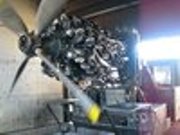While jet engines certainly elevated the performance of aircraft to the incredible levels we see today, there is no denying that the massive old radial jobs that won WWII are some of the baddest power plants of all time. Take this video for example. It depicts the first start up of a freshly rebuilt Pratt and Whitney 4360. We’re talking about a 28 cylinder engine that can generate upwards of 3,500hp and provided the power to such historic aircraft as the B-50 and in the case of this particular engine a Corsair.
Apparently the big radials were maintenance heavy and had a teardown schedule of about 600 hours. We’re not sure if severe duty flying shortened that up a all, but we merely cringe at the though of having to run the 56 spark plugs this monster takes in and out, let alone rebuild the whole thing!
The motor is fired up on a test stand and one thing that stuck out to us was the fact that it is so big and so long, yet appears to be bolted to the stand just from the back like you would a small block on an rolling engine stand. We’re probably missing something in that process, but if not, there must be some mondo hardware holding this beast on!
Crank up the speakers and press play to hear a sound you literally don’t hear every day, the fury of a mighty Pratt and Whitney R-4360 radial!























Mount one of those on your wrecker Brian and “strafe” your neighborhood.They were also used on the C-119 “Flying Boxcar”.
Well the engine stand IS a truck.
Actually, mounted from the back is how they were under the cowl of the Corsair on an engine mount that was gas welded no less. From the cockpit to the spinner is about 15 to 18 feet. The Corsair is one of the most popular airplanes ever built. There are some for sale as high as 3 million in case you were interested. This rebuild probably was about 150k… ~J~
Sadly, the Super Corsair this engine was built for crashed in a field in North Dakota practicing for an airshow. The plane was destroyed, and the pilot / restorer Bob Odegaard was killed.
http://www.newsdakota.com/2012/09/07/breaking-pilot-dies-in-airplane-crash-at-barnes-county-airport/
We had a couple of these in A&P school back in 1969. Very impressive and when we got there in the morning some times they would hand us a Mag and we had to get it running. Thanks for ti link. The cams on those radials looks like a flower. and aloays have an odd number of jugs…
Cool old engine. I know where a supercharged version sits out in the weather!
I wonder how much HP was lost for lack of a collector
Wasn’t that engine called a Wasp Major?
Yes, the PW 4360 was officially known as the “Wasp Major”; in the field, it’s known as a “corncob”, and powered many of the larger propliners and cargo planes. A list of planes powered by the mighty corncob can be found here:
http://en.wikipedia.org/wiki/Pratt_&_Whitney_R-4360_Wasp_Major
Also, this engine was only used on the last Corsair model, the F2G Super Corsair, which was intended as a kamikaze interceptor, but wasn’t put into large scale production because the war ended and it wasn’t needed for that purpose.
http://en.wikipedia.org/wiki/Goodyear_F2G_Corsair
Production Corsairs that saw service in WWII were powered by the famous P&W R2800 double wasp engine, same as used in F6F Hellcats, P-47 Thunderbolts, F7F Tigercats, F8F Bearcats, etc.
http://en.wikipedia.org/wiki/Pratt_&_Whitney_R-2800_Double_Wasp
-Tom
howee heallll